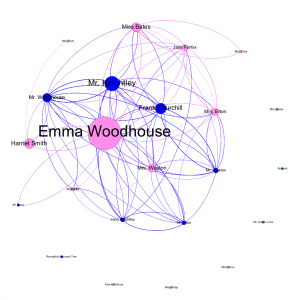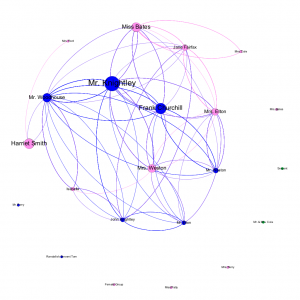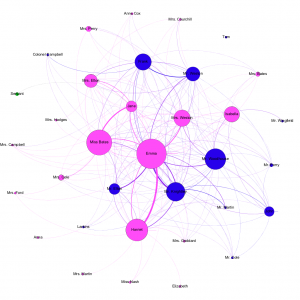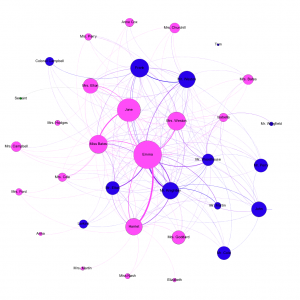https://bowdoin.ensemblevideo.com/Watch/Austen1
A manually interpreted graph of gossip in Volume 2, Chapter 3. Each edge begins with the character speaking and terminates at the character being spoken to. Female nodes are pink, and male ones are blue. The nodes are sized by out-degree, so characters who talk more appear as larger nodes.
Consider the above graph, which portrays dialogue from one character to another in Volume 2, Chapter 3. In this graph, each edge connects the character speaking to his or her audience. Notable in graphically representing this conversation is the notion of time. In this representation, each paragraph of dialogue is considered as one unit of narrative time, regardless of the length of the paragraph. However, there is one instance in which Mr. Knightley and Mr. Woodhouse both jump to contradict Emma’s self-deprecation “nearly at the same time” (134). This moment is represented in the graph as a simultaneous occurrence, rather than two separate pieces of dialogue. Of course, this method of representing conversation over time is inherently flawed, as it is dependent on textual units of time. A paragraph is not in reality a unit of time, but instead a unit of textual organization. However, for the purposes of representing an inherently textual interaction, this method does reveal the way a conversation moves between characters.
Another difficulty in representing conversations between people is the notion of generally addressing the room. Emma does this quite a bit when Miss Bates appears. For instance, the statement “Mr. Elton going to be married! He will have everybody’s wishes for his happiness” is not directed at any particular character, but rather the entire room (136). This is particularly difficult to capture graphically, as here Emma is not really addressing Mr. Woodhouse, Mr. Knightley, Miss Bates, and Jane individually, but rather addressing the group as a whole. This type of speech includes everyone generally rather than each participant individually. This social convention is perhaps what makes Miss Bates’s and Jane’s tangent about the physical qualities of Mr. Dixon so uncomfortable. The two have what is almost a private interaction in the midst of a public conversation, which is a jarring contradiction. Miss Bates briefly fails to include everyone by only talking to Jane, and this reads as a break in the normal flow of conversation, if only for a moment.

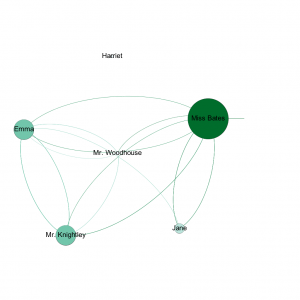
In contrast with the manually generated graph is the automatically generated one. In order to create this graph, I assumed that when each character speaks, the next speaker is the first speaker’s addressee. For instance, if Emma speaks and then Mr. Knightley speaks, this graph assumes that Emma is speaking to Mr. Knightley. This method of visualization draws attention to the characters speaking in a way that dialogue imbedded in the narrative does not, and it portrays that dialogue in such a way that nodes are either “on” or “off.” Although this makes a whole set of assumptions about the nature of conversation and its role in the book, the above two graphs are rather similar. Both are sized by in-degree, meaning that larger nodes are addressed in conversation more frequently. The manual version of the graph shows more nuance in differentiating the sizes of the nodes, and Emma, rather than Miss Bates, becomes the dominating presence. Mr. Knightley and Mr. Woodhouse are both also allowed greater share of the conversation, due to the phenomenon of addressing the group rather than the individual. We may take from these differences that, although Miss Bates speaks frequently, she is less often explicitly addressed. Further, although Mr. Knightley and Mr. Woodhouse are less frequent speakers, they are a significant part of the audience. This is perhaps indicative of a difference in class, as the most prominent speaker is the poor old maid while the most common listeners are the wealthiest characters. Those in power merely listen while Miss Bates takes advantage of her information to momentarily take the spotlight.
